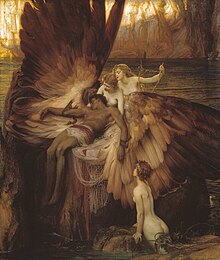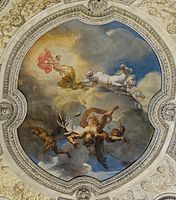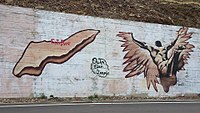Icarus

InGreek mythology,Icarus(/ˈɪkərəs/;Ancient Greek:Ἴκαρος,romanized:Íkaros,pronounced[ǐːkaros]) was the son of themaster craftsmanDaedalus,the architect of thelabyrinthofCrete.AfterTheseus,king ofAthensand enemy of Minos, escaped from the labyrinth,King Minossuspected that Icarus and Daedalus had revealed the labyrinth's secrets and imprisoned them—either in a large tower overlooking the ocean or in the labyrinth itself, depending upon the account.[1][2]Icarus and Daedalus escaped using wings Daedalus constructed from birds’ molted feathers, threads from blankets, the leather straps from their sandals, and beeswax.[3]Before escaping, Daedalus warned Icarus not to fly too low or the water would soak the feathers and not to fly too close to the sun or the heat would melt the wax.[3]Icarus ignored Daedalus's instructions not to fly too close to the sun, causing the beeswax in his wings to melt. Icarus fell from the sky, plunged into the sea, and drowned. The myth gave rise to the idiom, "fly too close to the sun."In some versions of the tale, Daedalus and Icarus escape by ship.[1][4]
The legend
[edit]

Icarus's fatherDaedalus,a very talentedAtheniancraftsman, built alabyrinthforKing Minosof Crete near his palace atKnossosto imprison theMinotaur,a half-man, half-bull monster born of his wife and theCretan bull.Minos imprisoned Daedalus himself in the labyrinth because he believed Daedalus gave Minos's daughter,Ariadne,aclew[5](or ball of string) in order to helpTheseusescape the labyrinth and defeat the Minotaur.


Daedalus fashioned two pairs of wings for himself and his son, made of metal feathers held to a leather frame by beeswax. Before trying to escape the island, he warned his son to follow his flight path and not fly too close to the sun or the sea. Overcome by giddiness while flying, Icarus disobeyed his father and soared higher into the sky. Without warning, the heat from the sun softened (and melted) the wax. Icarus could feel melted wax dripping down his arms. The feathers then fell one by one. Icarus kept flapping his "wings", trying to stay aloft. But he realized that he had no feathers left. He was only flapping his bare arms. He also saw loose feathers falling like snowflakes. Finally, he fell into the sea, sank to the bottom, and drowned. Daedalus wept for his son and called the nearest landIcaria(an island southwest ofSamos) in the memory of him.
He went to the temple and hung up his wings. And he promised that he would never again fly. Today, the supposed site of his burial on the island bears his name, and the sea near Icaria in which he drowned is called theIcarian Sea.[6][7][8]With much grief, Daedalus went to the temple of Apollo in Sicily, hung up his own wings as an offering, and promised to never attempt to fly again.[9]According toscholiaonEuripides,Icarus thought himself greater thanHelios,theSunhimself, and the god punished him by directing his powerful rays at him, melting the beeswax. Afterwards, it was Helios who named the Icarian Sea after Icarus.[10]
Hellenistic writers giveeuhemerisingvariants in which the escape from Crete was actually by boat, provided byPasiphaë,for which Daedalus invented the first sails, to outstrip Minos's pursuinggalleys,that Icarus fell overboard en route toSicilyand drowned, and thatHeracleserected a tomb for him.[11][12]
Classical literature
[edit]Accounts of Icarus's story are found in Pseudo-Apollodorus'sBibliotheca(Epitome i.12–13); Diodorus Siculus'sBibliotheca historica(4.77.5–9); Hyginus'sFabulae(40); Virgil'sAeneid(vi.14–33); and Ovid'sMetamorphoses(viii.183–235). A number of other ancient writers allude to the story in passing, notablyLucian.[13]
The account byPseudo-Apollodorusis brief.[14]Ovid's account in theMetamorphosesis among the lengthiest, and the Latin poet refers to Icarus's myth elsewhere.[15]Hyginus,among theAugustanwriters who wrote about it in Latin in hisFabulae,tells of the bovine love affair ofPasiphaë,daughter of the Sun, that resulted in the birth of theMinotaur.
Medieval, Renaissance, and modern literature
[edit]Ovid's version of the Icarus myth and its connection toPhaethoninfluenced the mythological tradition inEnglish literature[16]reflected in the writings ofChaucer,[17]Marlowe,[18]Shakespeare,[19]Milton,[20]andJoyce.[21]
In Renaissanceiconography,the significance of Icarus depends on context: in the Orion Fountain at Messina, he is one of many figures associated with water; but he is also shown on the Bankruptcy Court of the Amsterdam Town Hall – where hesymbolizeshigh-flying ambition.[22]The 16th-century paintingLandscape with the Fall of Icarus,[23][24]) attributed toPieter Bruegel the Elder,was the inspiration for two of the 20th century's most notableekphrasticEnglish-language poems, "Musée des Beaux Arts"byW. H. Audenand "Landscape with the Fall of Icarus"byWilliam Carlos Williams.[25]Other English-language poems referring to the Icarus myth are "To a Friend Whose Work Has Come to Triumph" byAnne Sexton;"Icarus" byJohn Updike;"Icarus Again" by Alan Devenish; "Mrs Icarus" byCarol Ann Duffy;"Failing and Flying" byJack Gilbert;"It Should Have Been Winter" by Nancy Chen Long, "Up like Icarus"by Mark Antony Owen," Age 10, 3am "by Sheri Wright, and" Yesterday's Myth "by Jennifer Chang. While the myth is a major subtext throughout Hiromi Yoshida's Icarus tetralogy poetry chapbooks, Icarus is a metaphor for troubled modern young men in the NorwegianAxel Jensen's novelIcarus: A Young Man in Sahara(1957). He is also the subject of the 2017 novel,Icarus,by Adam Wing.
-
The Sun, or the Fall of Icarus(1819) byMerry-Joseph Blondel,in the Rotunda of Apollo at theLouvre
-
A 16th century print of Icarus falling.[26]
-
InBruegel'sLandscape with the Fall of Icarus(c. 1558) the fallen Icarus is a small detail at lower right.
Interpretation
[edit]
Literary interpretation has considered the myth of Icarus as a consequence of excessive ambition.[27]An Icarus-related study of theDaedalusmyth was published by the FrenchhellenistFrançoise Frontisi-Ducroux.[28]In psychology, there have been synthetic studies of theIcarus complexwith respect to the alleged relationship between fascination for fire,enuresis,high ambition, and Ascensionism.[29]The term Icarus complex is defined by NGHIALAGI.net as, "A form of overcompensation wherein an individual, due to feelings of inferiority, formulates grandiose aspirations for future achievement despite lacking proper talent, experience, and/or personal connections. Such a person often exhibits elitism fueled by hubris and detachment from social reality."[30]In the psychiatric mind, features of disease were perceived in the shape of the pendulous emotional ecstatic-highand depressive-lowof bipolar disorder.Henry Murrayhaving proposed the termIcarus complex,apparently found symptoms particularly in mania where a person is fond of heights, fascinated by both fire and water,narcissisticand observed with fantastical orfar-fetched imaginarycognition.[31][32]Seth Godin's 2012The Icarus Deception,points to the historical change in how Western culture both propagated and interpreted the Icarus myth arguing that "We tend to forget that Icarus was also warned not to fly too low, because seawater would ruin the lift in his wings. Flying too low is even more dangerous than flying too high, because it feels deceptively safe."[33]Each study and analysis of the myth agrees Icarus was too ambitious for his own good.
See also
[edit]- Bladud,a legendary king of the Britons, purported to have met his death when his constructed wings failed
- Etana,a sort of "Babylonian Icarus"[34]
- Kua Fu,a Chinese myth about a giant who chased the sun and died while getting too close
- Sampati,an Indian myth about a bird which lost its wings while trying to save its younger brother from the sun
References
[edit]- ^abMarch, Jennifer R. (2014).Dictionary of Classical Mythology(2nd ed.). Oxford: Oxbow Books. p. 260.ISBN9781782976356.
- ^"Metamorphoses (Kline) 8, the Ovid Collection, Univ. of Virginia E-Text Center".ovid.lib.virginia.edu.Retrieved17 November2022.
- ^ab"CommonLit | The Myth of Daedalus and Icarus by Ovid".CommonLit.Retrieved17 October2022.
- ^Elder, Pliny the (21 May 2015).Pliny the Elder: The Natural History Book VII (with Book VIII 1–34).Bloomsbury Publishing. p. 236.ISBN978-1-4725-2101-9.
- ^clew– a ball of yarn or thread. The etymology of the word "clue"is a direct reference to this story of the Labyrinth.
- ^Graves, Robert(1955). "92 – Daedalus and Talus".The Greek Myths.Penguin Books.ISBN0-14-007602-6.
- ^Thomas Bullfinch- The Age of Fable Stories of Gods and HeroesKundaliniAwakeningSystemArchived24 January 2013 at theWayback Machine& The Internet Classics Archive by Daniel C. Stevenson: Ovid –Metamorphoses – Book VIII+ Translated byRolfe Humphries–KET Distance LearningArchived14 June 2012 at theWayback Machine24 January 2012.
- ^Translated byA. S. Kline–University of Virginia Library.eduRetrieved 3 July 2005.
- ^"Icarus and Daedalus.Pdf".Docslib.Retrieved28 November2022.
- ^Mastronarde, Donald J. (2017).Preliminary Studies On the Scholia to Euripides(PDF).Berkeley, California: California Classical Studies. pp. 149–150.ISBN9781939926104.
- ^Smith, William, ed. (1867).A Dictionary of Greek and Roman Biography and Mythology.
- ^Pinsent, J. (1982).Greek Mythology.New York: Peter Bedrick Books.ISBN0-600-55023-0.
- ^In theIcaromenippus(about Menippus's Icarus-like flight), but also inThe Dream,24;Essays in Portraiture,21;The Ship,46.
- ^Epitomeof theBibliotecai.12–13.
- ^Gareth D. Williams,Banished voices: readings in Ovid's Exile Poetry(Cambridge University Press, 1994), p. 132online.
- ^Peter Knox,A Companion to Ovid(Blackwell, 2009), p. 424online.
- ^Jane Chance,The Mythographic Chaucer(University of Michigan Press, 1995), p. 65online.
- ^Troni Y. Grande,Marlovian Tragedy(Associated University Presses, 1990), pp. 14online,40–42et passim;Frederic B. Tromly,Playing with Desire: Christopher Tantalization(University of Toronto Press, 1998), p. 181.
- ^Coppélia Kahn,Man's estate: Masculine Identity in Shakespeare(University of California Press, 1981), p. 53online.
- ^Su Fang Nu,Literature and the Politics of Family in Seventeenth-Century England(Cambridge University Press, 2007), p. 154online;R.J. Zwi Werblowsky,Lucifer and Prometheus(Routledge, 2001, reprinted from 1952), p. 32online.
- ^R. J. Schork,Latin and Roman Culture in Joyce(University Press of Florida, 1997), p. 160online.
- ^E. H. Gombrich,Symbolic Images; Studies in the Art of the Renaissance(London, 1972); p. 8.
- ^"On doute que l'exécution soit de Pieter I Bruegel mais la conception Lui est par contre attribuée avec certitude",Royal Museums of Fine Arts of Belgium."Description détaillée"(in French). Archived from the original on 27 March 2012. Retrieved 3 September 2011.
- ^de Vries, Lyckle (2003). "Bruegel's" Fall of Icarus ": Ovid or Solomon?". Simiolus: Netherlands Quarterly for the History of Art. Stichting voor Nederlandse Kunsthistorische Publicaties. 30 (1/2): 4–18.JSTOR3780948.
- ^"Ten of the best: examples of ekphrasis".the Guardian.14 November 2009.Retrieved17 November2022.
- ^"De val van Icarus".lib.ugent.be.Retrieved2 October2020.
- ^Jacob E. Nyenhuis – Myth and the creative process: Michael Ayrton and the myth of Daedalus, the maze maker – 345 pagesWayne State University Press, 2003Retrieved 24 January 2012ISBN0-8143-3002-9 See also Harry Levin, The Overreacher, Harvard University Press, 1952[1]
- ^Frontisi-Ducroux, Françoise (1975).Dédale: Mythologie de l'artisan en Grèce Ancienne.Paris: François Maspero. p. 227.
- ^Wiklund, Nils (1978).The icarus complex.Lund: Doxa.ISBN91-578-0064-2.
- ^"Icarus Complex meaning and definition".nghialagi.net.Retrieved28 November2022.
- ^Michael Sperber 2010 – Dostoyevsky's Stalker and Other Essays on Psychopathology and the Arts, University Press of America, 2010, p. 166 ff,[2]ISBN0-7618-4993-9
- ^Pendulum –The BiPolar Organisation'squarterly journalBipolar UKRetrieved 24 January 2012.
- ^Godin, Seth (2012).The Icarus Deception: How High Will You Fly?(1st ed.). Portfolio.
- ^Comparison noted by W.H.Ph. Römer, "Religion of Ancient Mesopotamia", inHistoria Religionum: Religions of the Past(Brill, 1969), vol. 1, p. 163.
Further reading
[edit]- Graves, Robert,(1955) 1960.The Greek Myths,section 92passim
- Pinsent, J. (1982).Greek Mythology.New York: Peter Bedrick Books
- Smith, William, ed.A Dictionary of Greek and Roman Biography and Mythology


![A 16th century print of Icarus falling.[26]](https://upload.wikimedia.org/wikipedia/commons/thumb/f/f6/De_val_van_Icarus.jpg/200px-De_val_van_Icarus.jpg)

